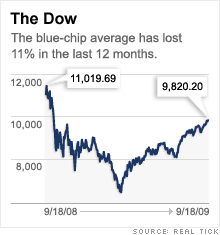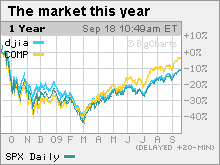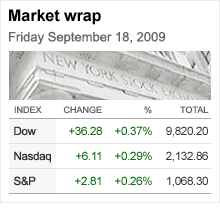Dow nears one-year highs
Wall Street stretches the recent rally, with the blue-chip average closing at the highest point since October 2008.




NEW YORK (CNNMoney.com) -- Wall Street stretched to new one-year highs Friday as investors weighed economic optimism with jitters about the pace of the rally amid the "quadruple witching," a big quarterly options expiration.
The Dow Jones industrial average (INDU) gained 36 points, or 0.4%. The blue-chip average closed at its highest point since Oct. 6, 2008.
The S&P 500 (SPX) index rose about 3 points, or 0.3% and closed just shy of a fresh almost one-year high.
The Nasdaq composite (COMP) added 6 points, or 0.3% and closed just shy of a one-year high.
The major indexes have now risen in 9 of the last 11 sessions.
But trading was choppy Friday due to the quadruple options expiration, a quarterly event when stock index futures and options and individual stock futures and options all expire at the same time. By the afternoon, attendance was light, due to the start of Rosh Hashanah, the Jewish new year.
Stocks ended just below unchanged Thursday after closing Wednesday's session at the highest point in nearly a year. Since bottoming at a 12-year low March 9, the S&P 500 has gained 58% and the Dow has gained 50%. Since bottoming at a six-year low, the Nasdaq has gained 68%.
Stocks have risen during those 6-1/2 months thanks to slowly improving economic news and extraordinary amounts of fiscal and monetary stimulus.
But consumer sentiment is still well below what it should be and that's creating some hesitation for investors, said Kelli Hill, portfolio manager at Ashfield Capital Partners. "The issue now is, what is it going to take for consumers to get back in and spend," she said.
Stocks have avoided the much-discussed September selloff, but Hill said it may have just been postponed until October, when the third-quarter profit reports start arriving. "Expectations for a broad earnings recovery could prove disappointing and that could create more volatility."
Economy: Michigan, Nevada and three other states posted unemployment rates above 12% in August, according to government data released Friday.
The report came one day after the Labor Department reported a surprise drop in weekly unemployment claims. Earlier this month, the government said employers cut 216,000 jobs from their payrolls in August.
On the move: Procter & Gamble (PG, Fortune 500) rallied 3.2% and was among the Dow's biggest gainers after Citigroup upgraded it to "buy" from "hold."
Other Dow gainers included components Chevron (CVX, Fortune 500), Hewlett-Packard (HPQ, Fortune 500), Home Depot (HD, Fortune 500), Pfizer (PFE, Fortune 500), Coca-Cola (KO, Fortune 500) and AT&T (T, Fortune 500).
Palm (PALM) said late Thursday that smartphone sales surged 134% to 823,000 last quarter, thanks to sales of its Pre phone. However, the company still reported a steep quarterly loss, its 9th consecutive decline. Shares fell 3%.
Market breadth was positive. On the New York Stock Exchange, winners topped losers by nearly three to two on volume of 2.27 billion shares. On the Nasdaq, advancers narrowly topped losers on volume of 3.2 billion shares.
Flash trading: The Securities and Exchange Commission proposed banning so-called flash orders Thursday, a trading practice that critics say gives market pros an unfair advantage over individual investors.
Flash orders allow certain traders to see orders to buy and sell stocks and other securities a split second before the rest of Wall Street, giving them advance knowledge about the direction of a market or a security. Flash orders make up less than 3% of stock trading.
Sens. Charles Schumer, D-N.Y., and Ted Kaufman, D-Del., have led the legislative push. But supporters worry that the government will also begin a crackdown on other kinds of trading practices that can help move the market along.
Nasdaq OMX Group, which runs the Nasdaq Stock Market and the BATS exchange stopped using flash orders as of Sept. 1. The New York Stock Exchange, owned by NYSE Euronext, has never used them. Currently, Direct Edge makes use of them.
Regulators are also looking at new limits on the credit ratings industry, dominated by Moody's, Fitch and Standard & Poor's.
Currency and commodities: The dollar gained against the yen and euro after sliding for most of the last two weeks. The dollar hit a 9-month low against the euro and a 7-month low against the yen earlier this week.
The falling greenback has been lifting dollar-traded commodities lately, but the reversal Friday had little impact on the price of oil or gold.
U.S. light crude oil for October delivery fell 43 cents to settle at $72.04 a barrel on the New York Mercantile Exchange. COMEX gold for December delivery fell $3.20 to settle at $1,010.30 an ounce. Gold settled Wednesday at a record high of $1,020.20.
Bonds: Treasury prices fell, raising the yield on the benchmark 10-year note to 3.45% from 3.39% Wednesday. Treasury prices and yields move in opposite directions.
World markets: Global markets were mixed. In Europe, London's FTSE 100 ended higher, but France's CAC 40 and Germany's DAX all slipped. Asian markets ended lower. ![]()
Crisis dodged: No shutdown for Philadelphia
Trade your old iPod for cash
Worker morale gets beat down
There is life after Lehman
Ranking the rescues
Fighting off the Bear: Seven stories
5 lessons from the crash
50 Most Powerful Women
Bernanke: Fed's unlikely risk taker
100 Fastest-growing companies
50 years of profit swings


